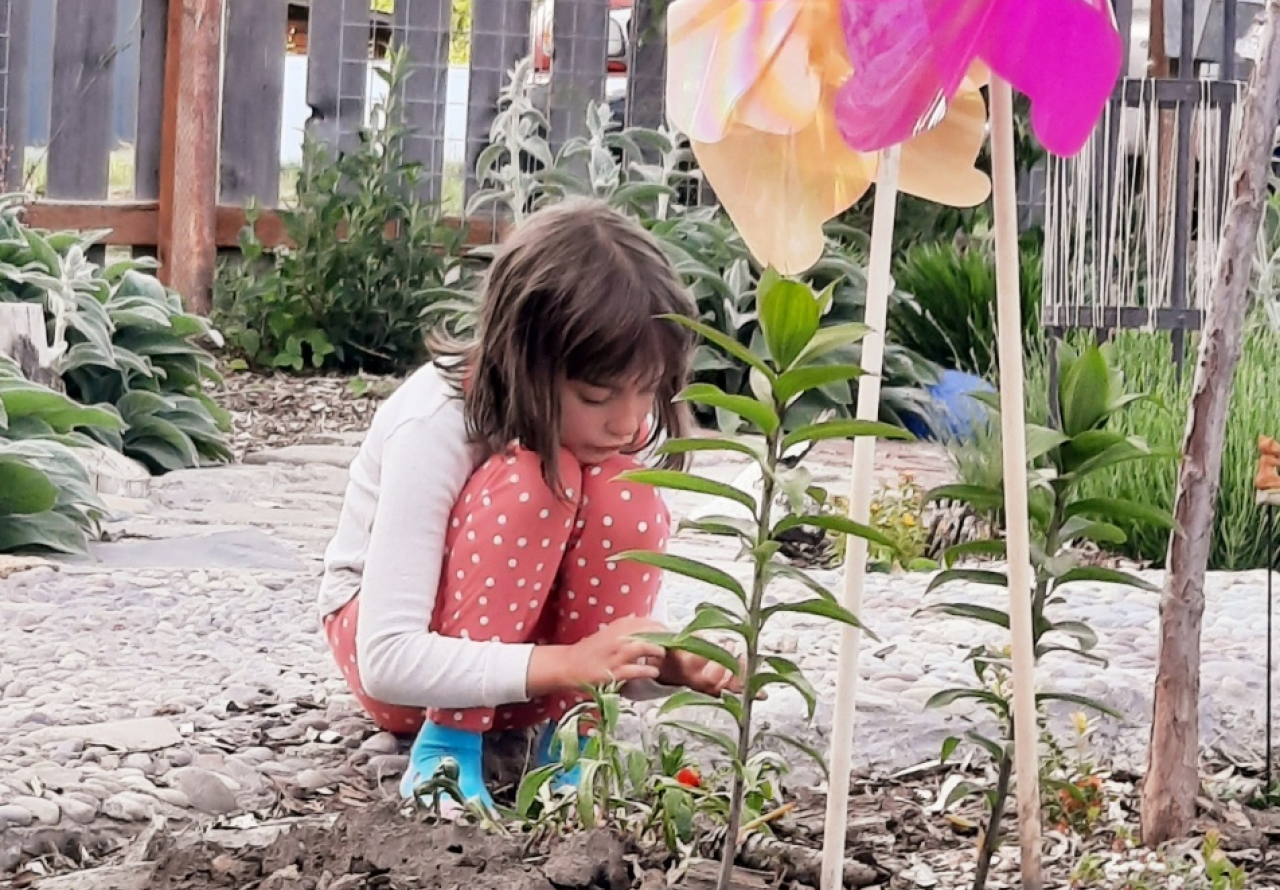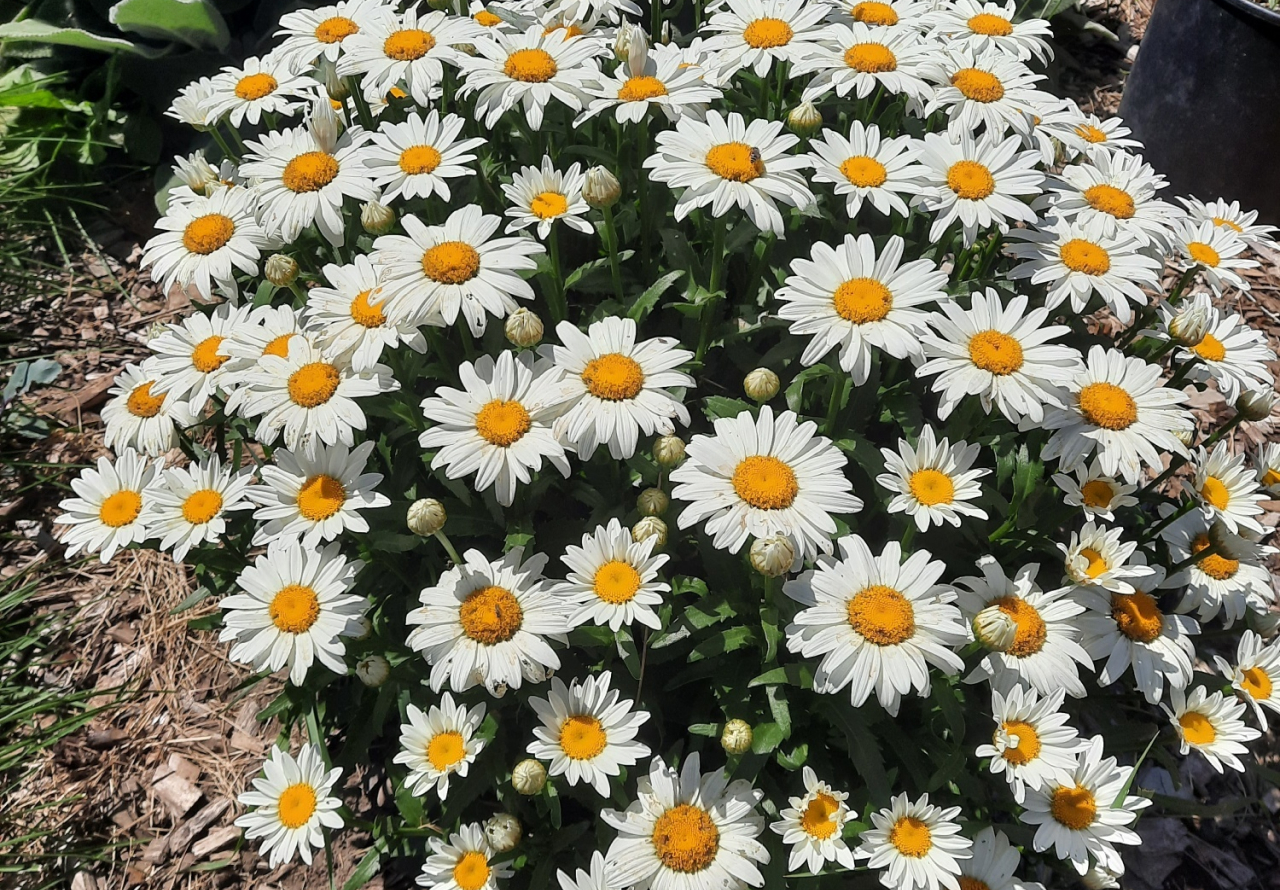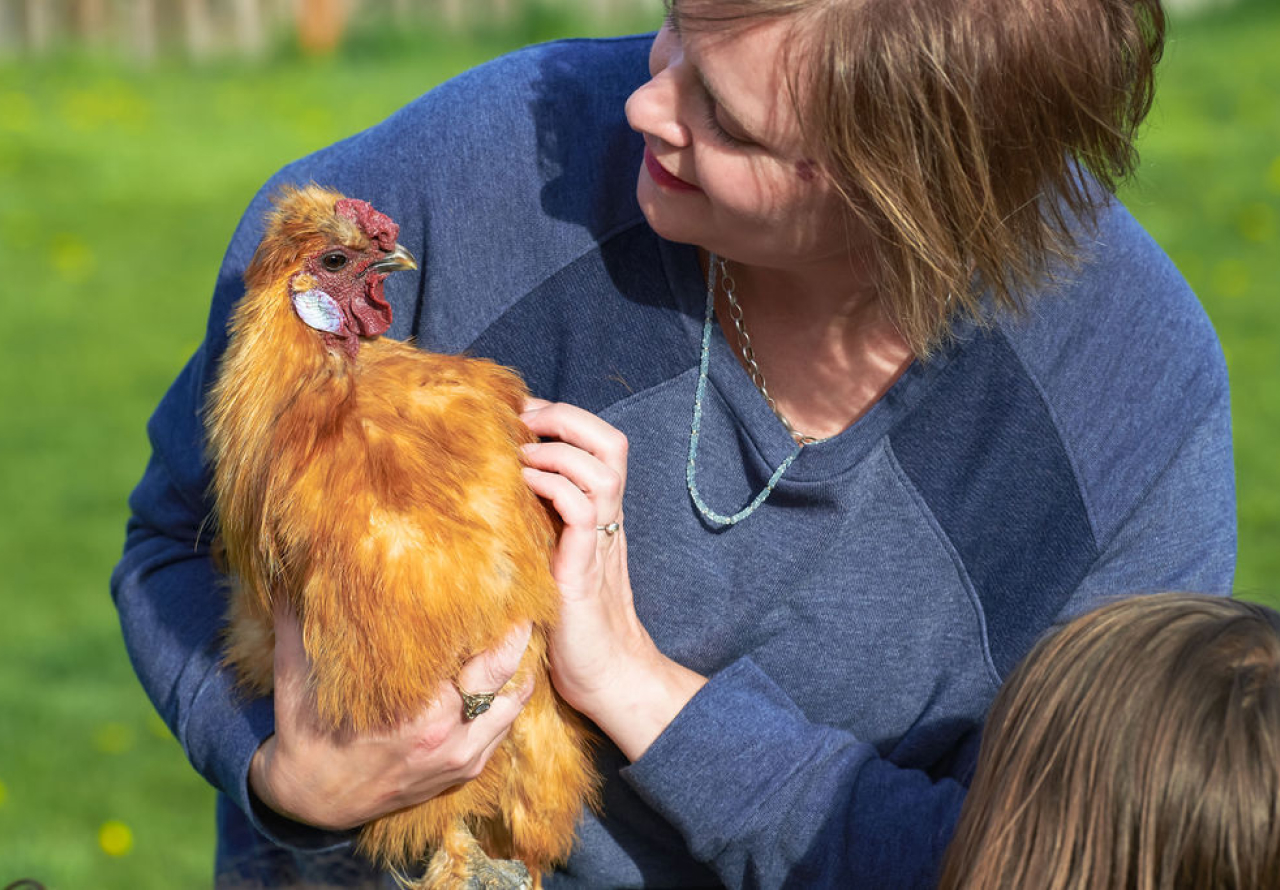If you're a person/mom with big, audacious dreams (my favorite kind) I recommend checking out Mel Findlater's work at Permission to be Human. I had a chance to sit down with Mel earlier this summer and dig in deep on what nature has to do with our ability to express and experience our biggest, best, most fully-lived selves...as moms, as women, and as humans that the world really needs right now.
Mel and I also talk about <surprise!> sensory-rich nature play and how nature can be a co-collaborator and support in your parenting journey.
Listen in to our conversation right here.
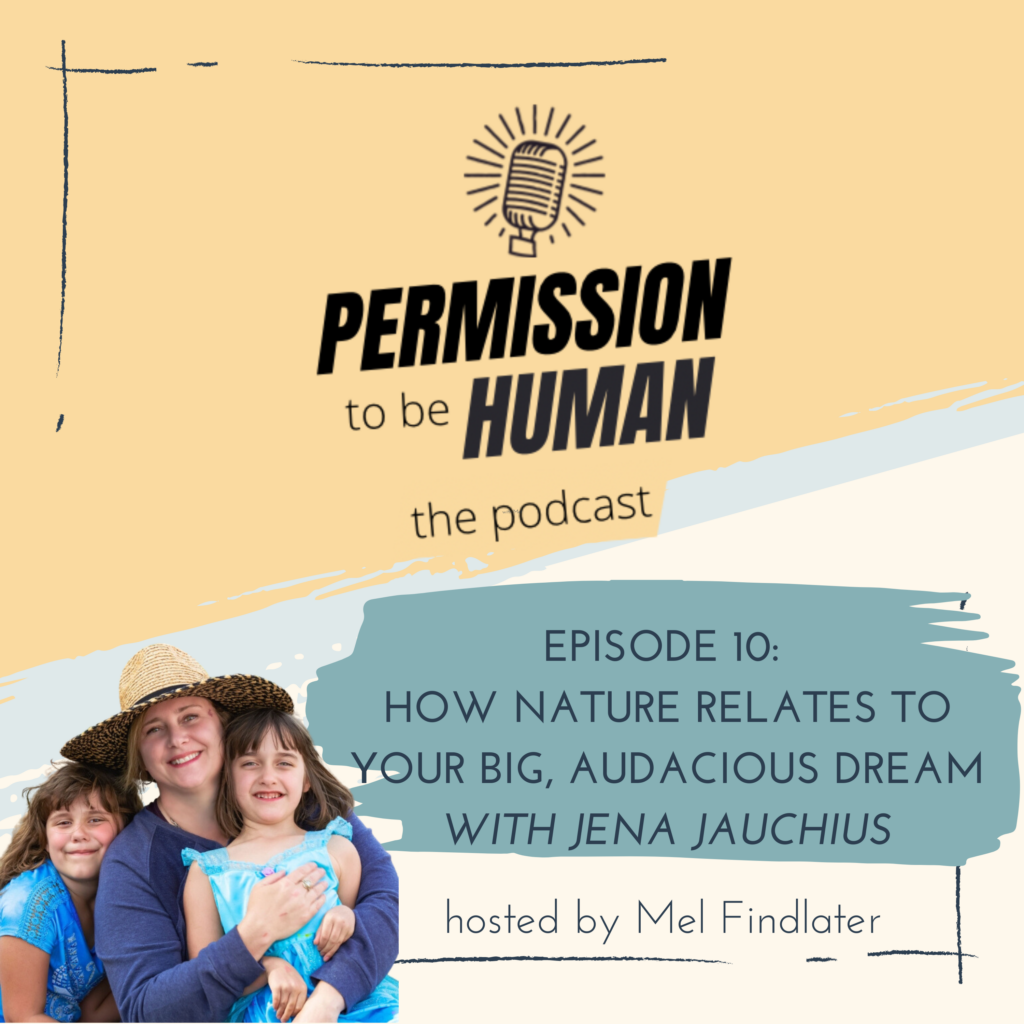
Provided by Early Childhood Investigations
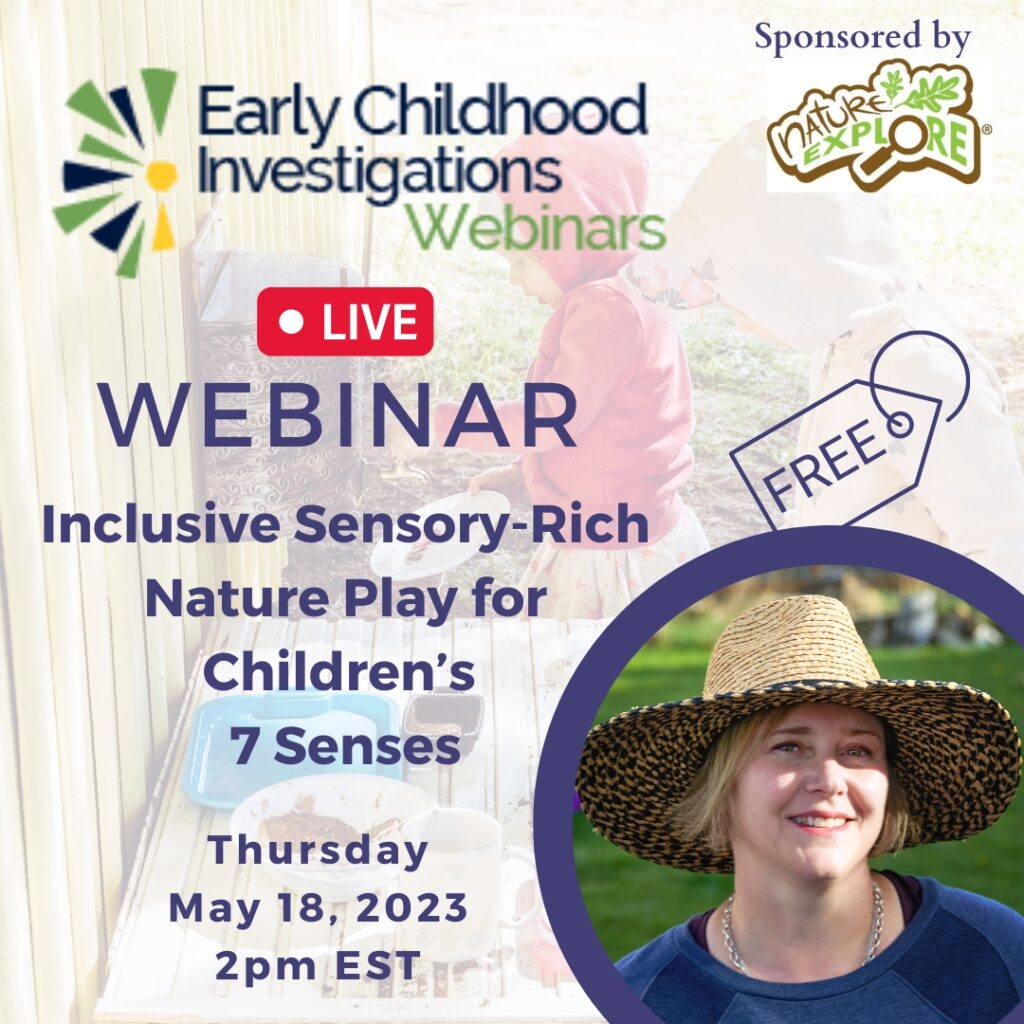
Nature play is one of the most powerful tools we have to give children the type of childhood they need to grow into thriving adults. Nature play calms children’s nervous system, offers the most beneficial sensory stimulation, and is an eager co-creator in play and learning. The benefits of nature play are increasingly recognized, however there is an essential aspect of nature play that has yet to be fully explored: the multi-sensory value of nature play and how it helps children grow into more complex, balanced, and joyful human beings.
This inspiring session will provide in-depth insights about children’s seven senses (there’s not just five!) and how they influence play, learning, and connection. We’ll cover why children need sensory-rich nature play and learning environments, and how we can tailor the sensory experiences of these environments to the individual needs of children, particularly neurodiverse children. By creating sensory-supportive nature-based places for children, ones they experience daily, we are better able to nurture our young in a way they can realize their true, full potential.
This webinar will help you see your outdoor play and learning space with new eyes. It will teach you to look through the lens of the senses, which are the closest adults can get to seeing the magical, experiential way kids see their world.
In this session you will:
CEUs and Certificates are available for attendance!
And a big thanks to my webinar sponsor, Nature Explore
Register for FREE to watch the REPLAY here!
I had the opportunity to sit down with Andrew Bartolotta, with CityCURRENT, about...you guessed it!...the power of sensory-rich nature play! Andrew and I went on a deep dive into how nature play stimulates not just five, but SEVEN sensory systems in children, and why it's vital for their holistic growth.
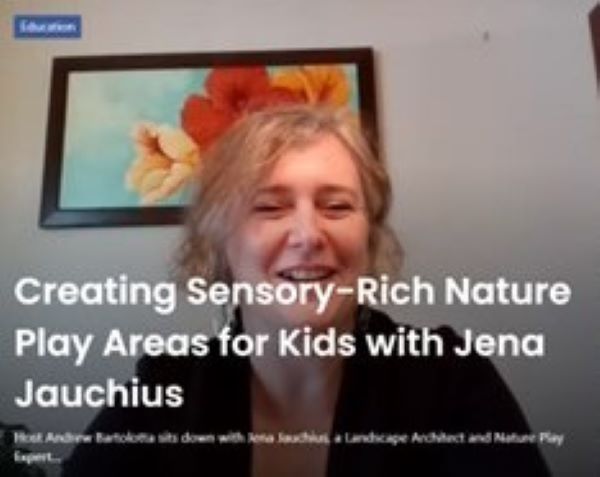
Andrew says "If you're seeking inspiration on how to transform your backyard into a sensory-rich playscape, or simply want to understand the profound power of nature in child development, this interview is a MUST-WATCH."
Victoria Hackett, with Outdoor Classrooms, is an educator who supports and provides resources for other educators, early childhood professionals, and parents interested in creating outdoor classrooms and backyard learning gardens.
Back in March, we had a super fun conversation about the intersection of outdoor learning and sensory experiences.
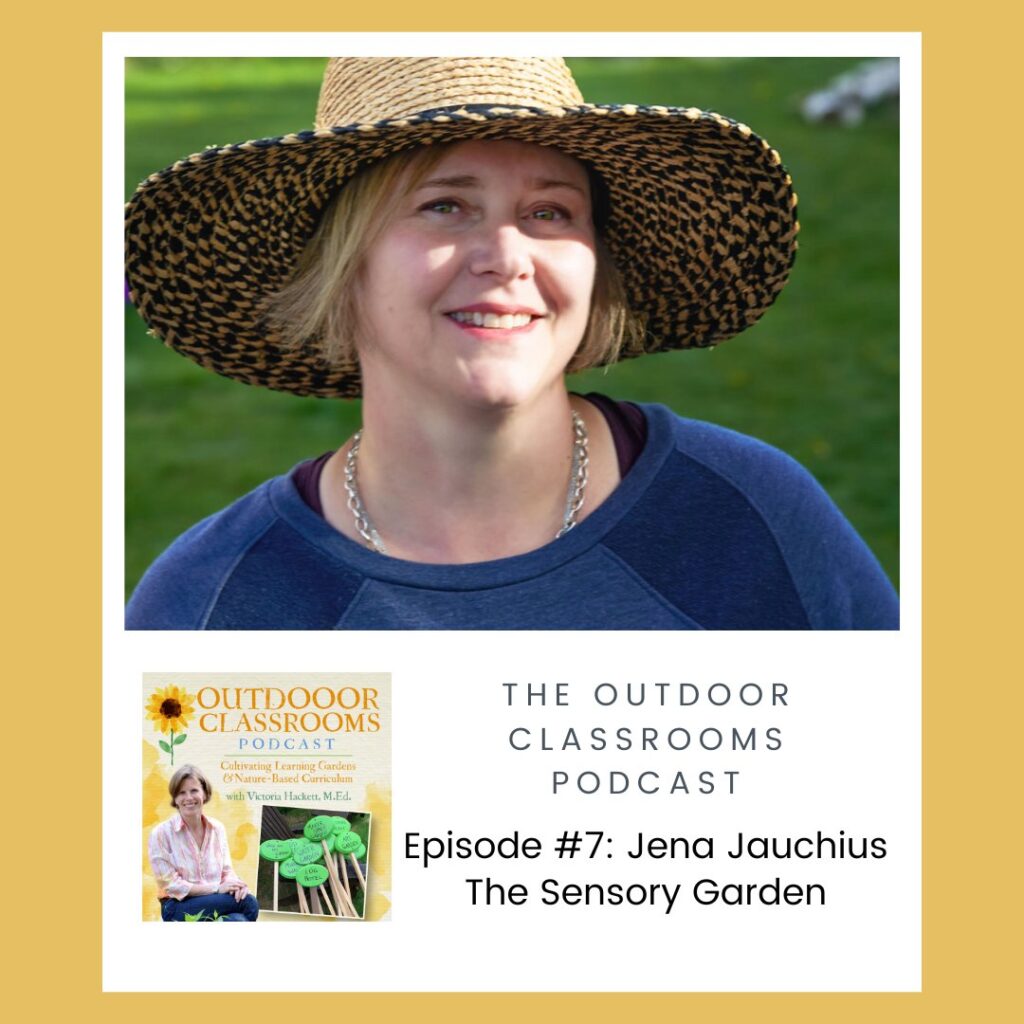
We talked about:
![]() sensory-rich nature play and why ALL kids need it in their day
sensory-rich nature play and why ALL kids need it in their day
![]() some of my favorite sensory features that are easy DIY projects
some of my favorite sensory features that are easy DIY projects
![]() the magic of childhood and power of connection
the magic of childhood and power of connection
Listen in to our conversation here (scroll down to Episode #7)
Proprioception is our body awareness sense!
Our proprioceptive (pro-pree-oh-cep-tive) system tells us where our bodies are relative to the things around us, and where our limbs are relative to our bodies.
Close your eyes and touch your nose with your pointer finger. This is your proprioceptive system at work!
Proprioception also has to do with the use of force necessary to do an activity, like coloring with a crayon with the right amount of force/pressure to not break it.
Just like the vestibular system, children’s proprioceptive system feeds on movement-based activities. A few play activities include:
CLIMBING up something and JUMPING off it, like boulders or a short set of logs, is great proprioceptive input. Many different muscles are being used and pressure is put on the upper and lower body joints. Balance and coordination skills are improved for better body confidence.
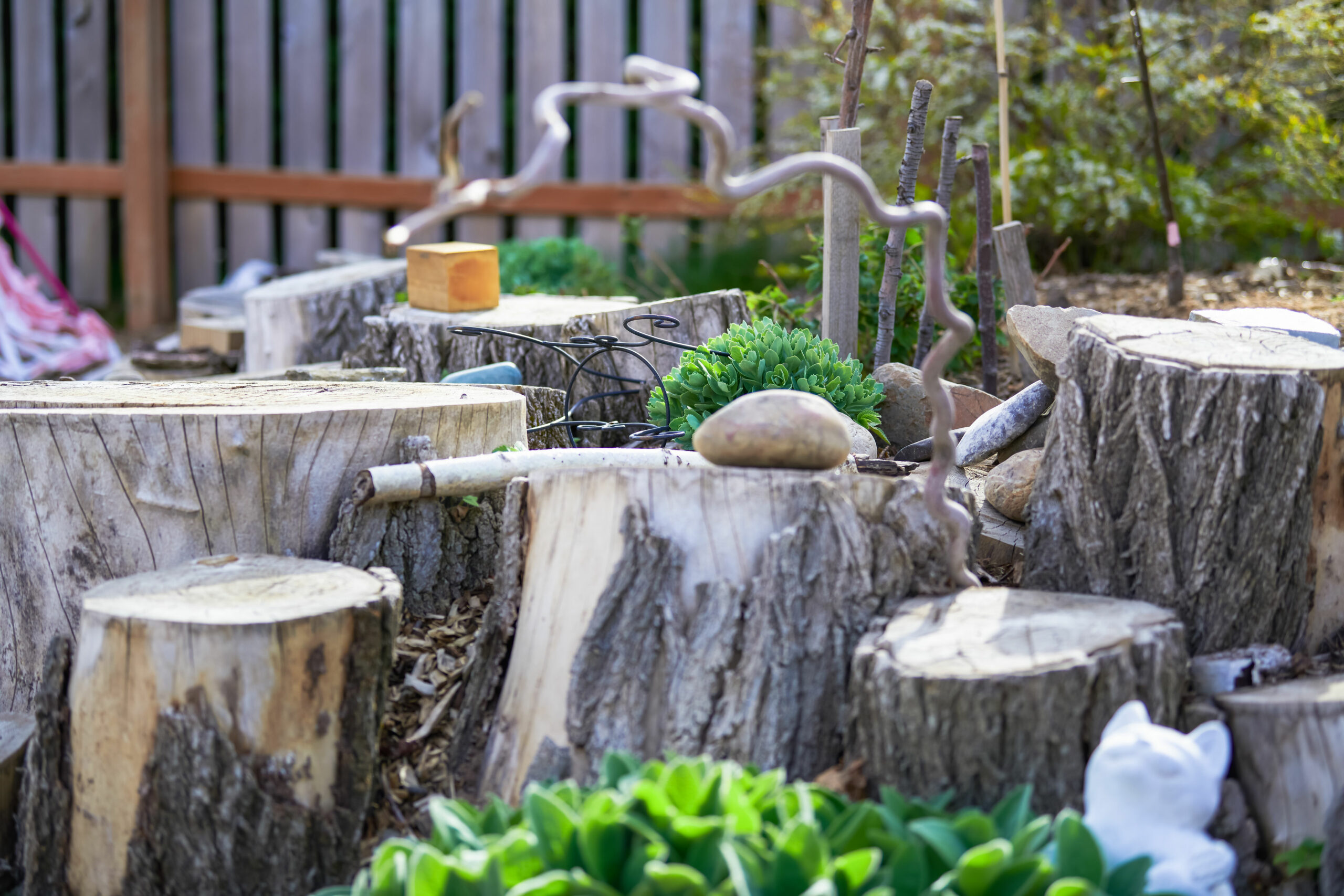
Big body movements like climbing and balancing feeds their proprioceptive system and increases body confidence.
Photo credit: Hara Allison Photography
GARDENING is filled with proprioceptive promise! Kids can use their bodies and tools in so many different ways while gardening. From planting seeds, to using a hand trowel, to raking, their bodies are getting good doses of stimulation.
When kids are PUSHING a child-sized wheelbarrow or PULLING a wagon are amazing play activities that involve balance, strength, and resistance.
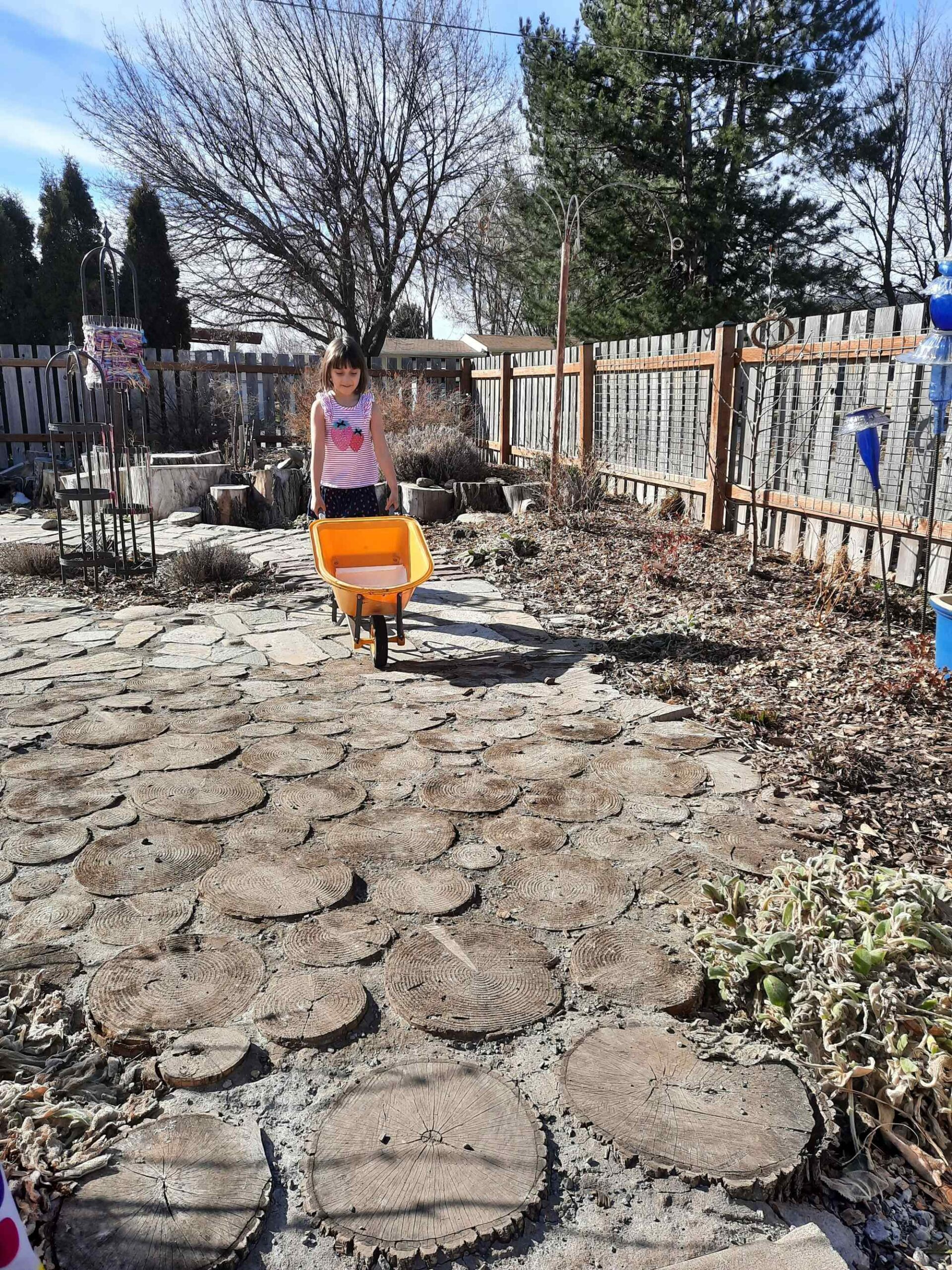
Pushing a wheelbarrow full of water across a sensory path gives this little body some high-intensity proprioceptive stimulation!
HUGGING is gives deep pressure and calms the nervous system.
Playing with LOOSE PARTS, like branches, stones, pinecones, seed pods, and other natural materials, involves movement, balance, fine motor skills, and other activities for proprioceptive input.
ONE OF THE KEYS OF SENSORY PLAY is that children must be given the opportunity to find the right intensity of sensory stimulation for their systems. Not all kids seek the same sensory experience or the same intensity of that experience.
Providing varying intensities of proprioception looks like this:
Pulling a wagon that is empty (less stimulation) compared to pulling a wagon that is full of play props or friends (more stimulation).
Using a watering can that is partially full (less stimulation) compared to using a watering can that is full (more stimulation).
How can your kiddo feed their proprioceptive system in their play space?
How can sensory plants promote body awareness in children? That’s a darn good question and a fun one to brainstorm a few answers:
First, plants are awesome for loose parts play! I always toot the Loose Parts horn loud and proud because it’s an incredible multi-sensory activity, including proprioceptive value.
Ornamental grasses with fun seed heads that can be picked and used for loose parts play. Or, Autumn Joy sedum, which has an incredible fall seed head which can be used during the cold months for winter-time play activities.
Many evergreen trees and shrubs provide cones of all shapes, sizes, textures, and colors which are fun to build with.
Second, edible sensory plants often provide proprioceptive input, as well.
For example, if you have several blueberry bushes planted in your kiddo’s play area, kids will walk around the bushes to search for ripe berries, possibly squatting, bending, and moving aside branches to find a cache. They’ll also use their fingers to pick the ripe berries (pressure/force/coordination), and put them in their mouths (eye-hand coordination)
Gardening is one of my favorite activities for proprioception stimulation. Everything from planting seeds, to watering, to transplanting seedlings, to pruning, to picking and eating their harvest gives beneficial proprioceptive stimulation. Add in some different garden tools for extra value!
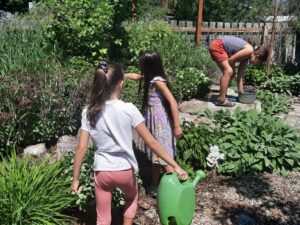
Proprioception in the garden looks like this. Hefting a watering can, climbing and balancing on logs, walking on uneven surfaces, and more!
Check out my eBook, Nature Play for the 7 Senses: A Parent’s Guide for Natural PLay & Learning Spaces for ALL Children
In his amazing book “The Universal Sense: How Hearing Shapes the Mind”, author and neuroscientist Seth Horowitz says our auditory sense is 20x – 100x faster than any of our other senses.
That means everything else we experience is influenced by what we hear.
Additionally, sound is very much tied to our emotions. What does all this have to do with nature play??
Well, for kids, this means their play and learning experiences are informed first by the sounds they hear, whether or not they see the source of the sound. The emotions the sound evokes give them an indication of good or not so good, exciting or dull, safe or unsafe, and so on.
Sounds that are soothing, joyful, interesting, and otherwise positive help regulate our nervous system and bring us into sensory balance where we can play, learn, interact, create, and do all the marvelous things that happy humans do.
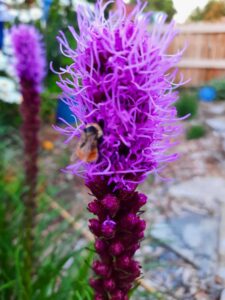
The buzzing of a honeybee can signal many feelings, including excitement or nervousness.
Sounds that are loud, jolting, irritating, raucous, and otherwise uncomfortable will send our nervous systems into 'flight or fight’. When our system is imbalanced, we are in survival mode and are only able to what’s absolutely essential to get through the situation.
For example, a child playing in a playground hears mom’s voice nearby which gives them the feeling that it’s ‘safe’ to play here. Even though mom isn’t in their field of vision, the child knows she’s there for them. Mom’s voice may evoke in them the feelings of calm, joy, love, and well-being. Feeling safe and happy, this kiddo can have positive play experiences, social interaction, and higher creativity.
For outdoor sensory play, I like to think of sound in 3 main types: nature sounds, social sounds, and musical sounds.
Nature sounds are birdsong, the breeze rustling the leaves of an aspen tree, toes wriggling in gritty sand, and water splashing. Studies show that nature sounds help calm our nervous system.
Social sounds, as you can guess, revolve around our personal interactions, like playing, talking, whispering, singing, laughing, crying, and shouting. Sometimes social sounds are positive, nurturing experiences, and sometimes they’re not.
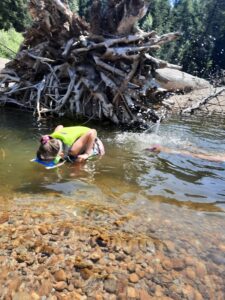
Splashing in the water at our favorite river spot.
And, of course, music is rich food for children’s developing bodies and brains.
Music has a lot going on: rhythm, harmony, vibration, singing, emotion. For children, listening to a song (which, for kids, also means moving and dancing) is a powerful sensory integration experience, and it also builds neural pathways in the brain, enhancing their cognitive ability.
Within each of these three types is vibration, or the feeling of sound. Each sound has a different sound wave, which we can feel through our skin/tactile sensory system. The vibrational feeling of a bass drum thumping compared to the vibration of a xylophone is very different, whether you’re putting your hands directly on the instruments or letting the sound waves hit your skin.
With sound also comes the need for quiet. A cozy space is an essential feature of any play area. I’ve talked about cozy spaces in earlier posts, but these are child-sized structures that give a child some personal space, often to self-regulate. A forts, a tipi, a nook carved out in the vegetation are examples.
What if you and your kiddo closed your eyes outside in their play area. What do you each hear? Does what you hear change with the seasons? How so? These are all great conversation to have with your little one. Encourage them to expand their vocabulary here.
How can you think of your child’s play space as a soundscape?
Children are always experimenting with sound. The natural world is a rich soundscape, where plant life takes center stage.
When you provide plants for sound experiences, you open up a new dimension of environmental learning for your kiddos to learn about the world around them and their interactions with it.
Seed pods rattle when shaken.
Tree leaves rustle in the breeze.
Ornamental grasses make inviting scratchy, swishy, swooshy sounds when kids brush by or the wind whistles through.
Here are a few plants that contribute to the symphony of a sound garden:
All Gold Japanese Forest Grass (Hakonechloa macra ‘All Gold’), hardiness zones 4-9
There are many options for kid-friendly ornamental grasses, but Japanese Forest Grass is one of my favorites. The primary reason being their leaf blades are smooth to the touch and very inviting. Whether kids brush it with their leg as they walk by or run their hands through it like their tousling someone’s hair, this happy little grass responds in pleasant swooshes. The All Gold variety has gorgeous golden yellow color to add some visual appeal and multi-sensory value.
18” tall and wide
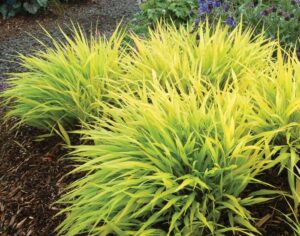
All Gold Japanese Forest loves to be rustled by little hands.
Silver Dollar Plant (Lunaria biennis), hardiness zones 5-9
This plant gets its name from the seedpod that form after it blooms in the spring. The roundish, flat pods start out green and turn an iridescent white over time the plant dries out. Each dried stalk has a mass of dried silver dollars on it and give a papery rattle sound when shaken. Considered a hardy annual in the northwest climate, they can spread enthusiastically by seed.
Approx. 30” tall x 18” wide
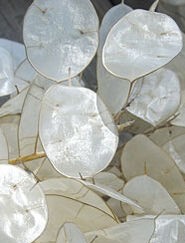
The seed pods of the Silver Dollar Plant have a raspy-papery-rattly sound.
Karl Foerster Feather Grass (Calamagrostis acutiflora ‘Karl Foerster’), hardiness zones 5-11
Feather reed grass is a favorite, and for good reason. These grasses can take a beating, I mean ‘loving’, from kiddos at play and shake it off like nuthin’ happened. I’ve planted this grass in a maze-like pattern in several playscapes. As kids wind their way through these grasses give off a happy rustling sound. Leave the seed heads on over the winter for four-season play opportunities.
4’-6’ tall and 2’-3’ wide
Quaking aspen, (Populus tremuloides), hardiness zones 2-6
Quaking aspen are magical trees. In cooler climates, they naturally grow in a variety of conditions. In the fall, their leaves turn a brilliant yellow like a ray of sunshine in the forest. This tree is named for the sound its leaves make in the wind. They quake, they tremble, they clack together and make the wind visible. Aspen spread by underground rhizomes, so if you have one aspen, you’re about to have more. If you have the room for this tree in your landscape, wonderful! If not, keep an eye (and an ear!) out for aspen groves when you go on family hikes.
50’ tall x 25’ wide
Again, be sure that all plants in the play area are non-toxic. And, always and forever, pesticides, herbicides, and other harmful chemicals should NEVER be used in play areas.
Check out my eBook, Nature Play for the 7 Senses: A Parent’s Guide for Natural PLay & Learning Spaces for ALL Children
All the ways kids love to move their bodies is informed by a sensory system that doesn’t get as much attention as the classic 5 senses.
Welcome to the VESTIBULAR SYSTEM! This is one of two movement-based sensory systems and equally important to our children’s holistic development and well-being as any of the other sensory systems.
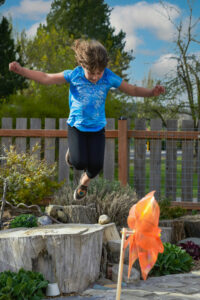
Photo credit: Hara Allison Photography
Our vestibular system is located in our inner ear. Through its complex workings, it detects where our head is relative to gravity and sends that information to our brain for processing. Are we right side up? Are we upside down? Are we sideways? Our vestibular system lets us know.
Have you ever had vertigo? You feel like the room is spinning around you. You feel off-balance. You’re dizzy. Vertigo is a sign of a very grumpy vestibular system.
Movement-based activities, especially those that require us to be something other than straight up and down, mold our vestibular system. The more kids move, the more they build their vestibular system.
There are lots of activities you can encourage your kids to do at home to stimulate their vestibular system. Some fun ideas include:
DANCING. This is an incredibly fun multi-sensory system experience for you and your kids! Dance party!
SWINGING. I love nest swings for this. These can be installed easily at home, indoors or outdoors.
BALANCING. Take a hose and arrange it in a squiggle in the lawn (or wherever works). Make a game out of who can balance the longest. Get creative and make it more and more challenging.
JUMPING. We installed a series of log segments in our sensory garden. My kids love to use these for all sorts of movement, jumping included.
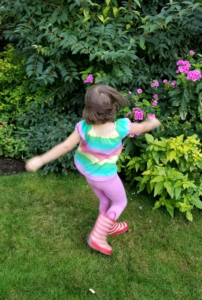
Spinning gives great vestibular input!
If your kiddo is SENSITIVE TO MOVEMENT, it’s important to let them be in charge of how much stimulation they get. Maybe they want to sit in a next swing and gently sway. Perhaps they’re only comfortable with gentle rocking. When they control their sensory experience, they feel safer and more in control of their bodies and their experiences.
How does your kiddo’s play area encourage movement?
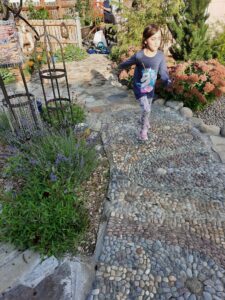
Sensory paths encourage kids to move their bodies in different ways and feed their vestibular system.
Ok, it’s a bit of a stretch to identify sensory plants for movement, but…challenge accepted!
The first thing that comes to mind is a favorite of young adventurers: climbing trees.
When I was a little girl, we had an incredible Norway maple in our backyard. Whenever I would climb up into its branches I felt like I was in another world. I felt safe. I felt connected. And, I always felt exhilarated figuring out how the heck to get back down which was always a combination of balancing, dangling, swinging, and a well-timed jump.
In my home now, my kids love an old cherry tree that was damaged years ago in a storm. When they were younger, they used to hang and swing from its branches. As they got a bit older, they’d love to climb the trunk to get up and sit on the lower branches.
This summer, my husband built a small fort in the storm-damaged opening in the canopy. Now, the girls can enjoy playing in the heart of their cherry tree. There’s nothing like a view from inside a tree canopy!
Another way plants can inspire movement is planting them in clusters for a maze-like effect. If you have some space, ornamental grasses, like Karl Foerster Feather Grass (Calamagrostis acutiflora ‘Karl Foerster’), are wonderful for this because they make swishing sounds as kids pass by.
Another idea is using log segments as climbing/balance features.

Photo credit: Hara Allison Photography
I have a big log round that was sawed in half. We turned it flat side up for a fun rocker.
Thinly sliced log segments, or log cookies, can be placed like stepping stones for hopping.
If you don’t have easy access to these sorts of natural materials, check out Facebook Marketplace, Craigslist, or other online platform. People are always giving these things away for free.
Don’t underestimate the natural connection that forms between your child and nature in this co-creative play experience. It’s such a beautiful thing!
Check out my eBook, Nature Play for the 7 Senses: A Parent’s Guide for Natural PLay & Learning Spaces for ALL Children
Aaaaaaaaaaaahhhhhhhhhhhhhhh! Smells like NATURE PLAY!
Let’s explore our fascinating olfactory system and all those wonderful scents, fragrances, aromas, and odors that emanate from outdoor play and learning.
Our sense of smell transcends time and space. This sense is connected with our memory, and one whiff of a particular scent transports us back in time to when that memory was created.
For me, the subtle, fleeting scent of peonies reminds me of instantly my grandfather, Julius, and my time spent at his rural farmhouse. When he wasn’t doing dairy farming, he was growing the most amazing, colorful flower gardens, which included masses of peonies. As a youngster, I used to bury my face in them and inhale deeply, comparing the fragrances of the different colors.
The sense of smell closely connects us with nature, literally. As I just mentioned, when we smell a flower, we put it up close to our face. We breathe it in. We inahle all the amazing smell molecules and they become part of us. The scent, beauty, and energy of the flower is gifted to us through our breath. We roll the leaves of the plant, crushing it, to make the smell even stronger. Through this interaction, our experience elevates.
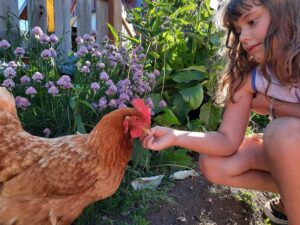
Nothings says “aroma” like farm animals! Caring for creatures is a multi-sensory experience and a way for kids to learn compassion and caring for others.
Adding different aromas to a play area can be done through fragrant plantings, water and sand play areas, areas where kids can dig in the soil, and compost areas (yes, kids like funky smells, too).
Signage can be helpful to communicate the use of the space, especially for kiddoes with autism and other neurodiversities who may deduce the sensory potential. Consider adding a little sign that says “Smell Me” so kids understand the purpose and are encouraged to explore their senses in this way.
To boost social skills and communication, ask them to describe what it is they’re smelling. Ask it how it makes them feel. Encourage them to expand their vocabulary beyond “good” or “bad”. Ask them how one plant’s smell compares with another’s. Have a conversation about it. You never know what you might learn.
So, with the olfactory system in mind: How many ways does your kiddos’ play space delight their sniffer? What else can you add to make it a fuller bouquet of aromas? Go experiment!
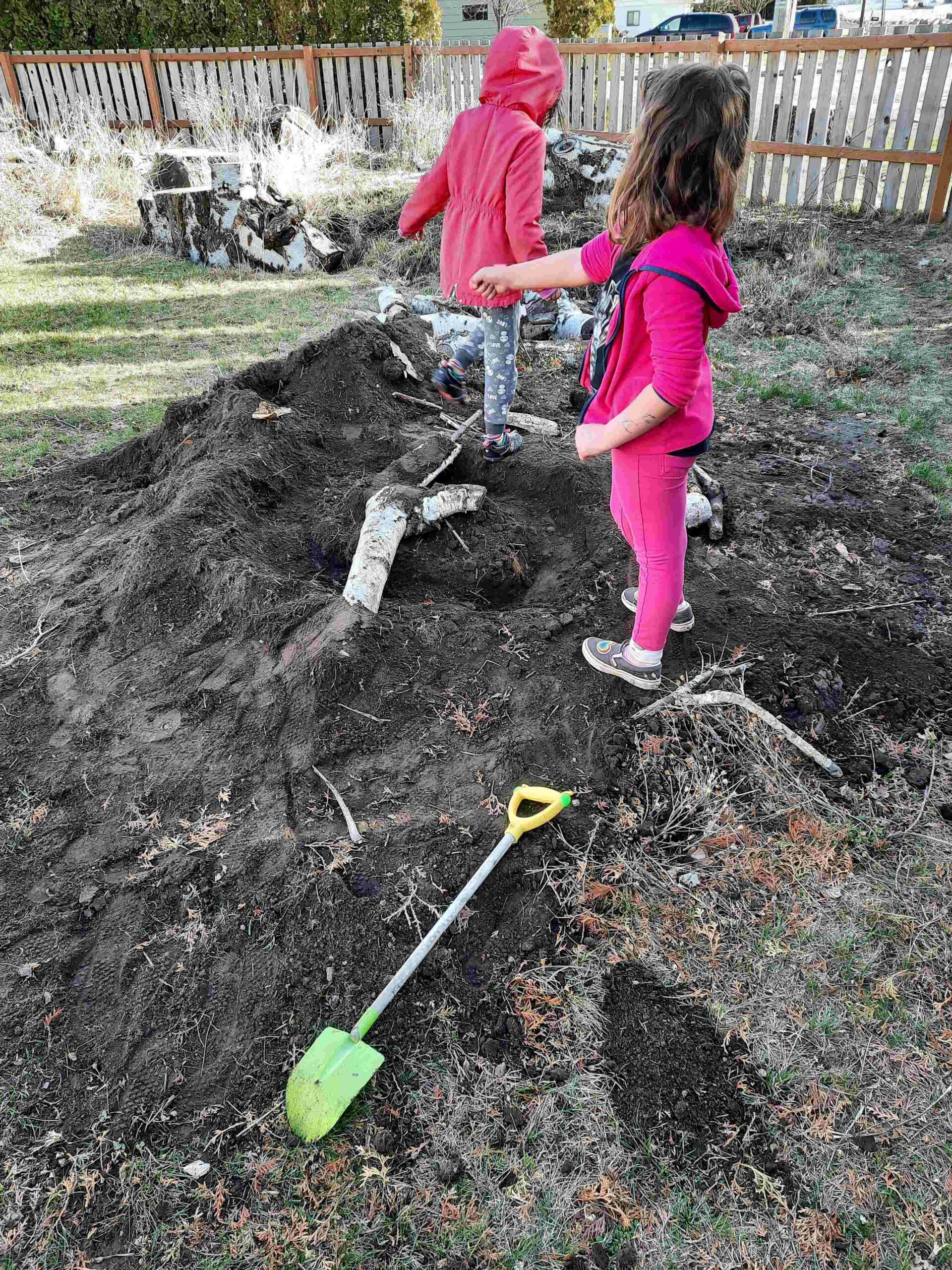
Digging is in the earth is one of the best multi-sensory activities kids can do. We are innately drawn to the smell of earth.
My girls had one of their little friends over for a play date. We were all out goofing around in our little sensory garden.
This little gal was zipping around, every once in a while stopping to smell this flower and that.
She flitted over to a chocolate cosmos plant and gently touched her nose to one of the decadent brown daisy-like blossoms.
I will never forget the look of sheer delight and surprise on her face!
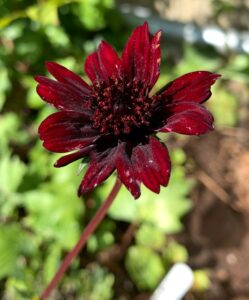
The magnificent, chocolate-smelling Chocolate Cosmos. No playscape should be without.
“This smells like a Hershey bar!!!” She gathered up my girls to share in the novelty of her unexpected, profound discovery.
The list of plants with amazing aromas is a very, very long one. Here are a few of my favorites that will turn your kids into hound dogs as they track down their favorite scents:
Chocolate cosmos (Cosmos atrosanguineus), hardiness zones 9-11
This incredible flower, as I already mentioned, has an extraordinary fragrance. Smelling of sweet chocolate it’s sure to be a favorite! An annual in my climate, I treasure this plant for the time I have it, and then replant again the following spring.
24” tall x 18” wide
Scented geraniums, hardiness zones 10-11
Mostly grown as annuals, scented geraniums come in dozens of different fragrances: apple, mint, chocolate mint, orange, lemon, citronella, rose, apricot, lime, peppermint, cinnamon, cedar, and more. I grow mine in containers and bring them inside when temps drop. I. LOVE. THESE. PLANTS.
Grosso lavender (Lavandula ‘Grosso’), hardiness zones 6-10
Lavender is known for its aroma-therapeutic properties and is one of the most popular fragrances in the world. This French lavender variety is used in fancy perfume concoctions because of its exceptional fragrance. The flower spikes are longer and more graceful than English lavender.
24” – 36” tall and wide
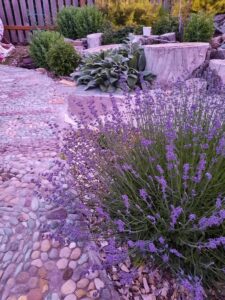
Lavender is a fabulous plant for children’s spaces because of it’s multi-sensory qualities, including its renowned fragrance.
Lilacs, hardiness zones 2-7, depending on the variety
These hardy shrubs perfume the spring air with their heady, sweet scent. It’s a crying shame that their bloom time is so stinkin’ short-lived. Not all lilacs are equally fragrant. For the most potent experience, I recommend ‘Miss Kim’ (lavender blue bloom, 6’ tall and wide), ‘Sensation’ (purple and white bloom, 10’ tall x 6’ wide), and ‘Maidens Blush (pink blooms, 8’ tall and wide).
Reine des Violettes Climbing Rose, hardiness zones 5-11
This nearly thornless rose is perfect for play spaces. Plant them to ramble along a fence or blanket a pergola. This rose produces highly fragrant, violet-colored flowers all summer long.
Climber to 10’ tall
Vanilla Spice Summersweet (Clethra alnifolia ‘Vanilla Spice), hardiness zones 4-9
The sweet-spicy fragrance of this summersweet will attract both children and pollinators! This low maintenance plant features whimsical white bottlebrush-shaped blooms all summer long.
3’-5’ tall and wide
Check out my eBook, Nature Play for the 7 Senses: A Parent’s Guide for Natural PLay & Learning Spaces for ALL Children
It’s time to channel your inner Willie Wonka because it’s time to talk about our sense of TASTE!
Our tiny little taste buds, located all over our tongue, roof of our mouth, and even in our throat, are incredible receptors of gustatory sensory information.
When we eat something, our taste receptors are stimulated. They send signals to the brain about their perception of that flavor: sweet, sour, salty, bitter, and umami (meaty).
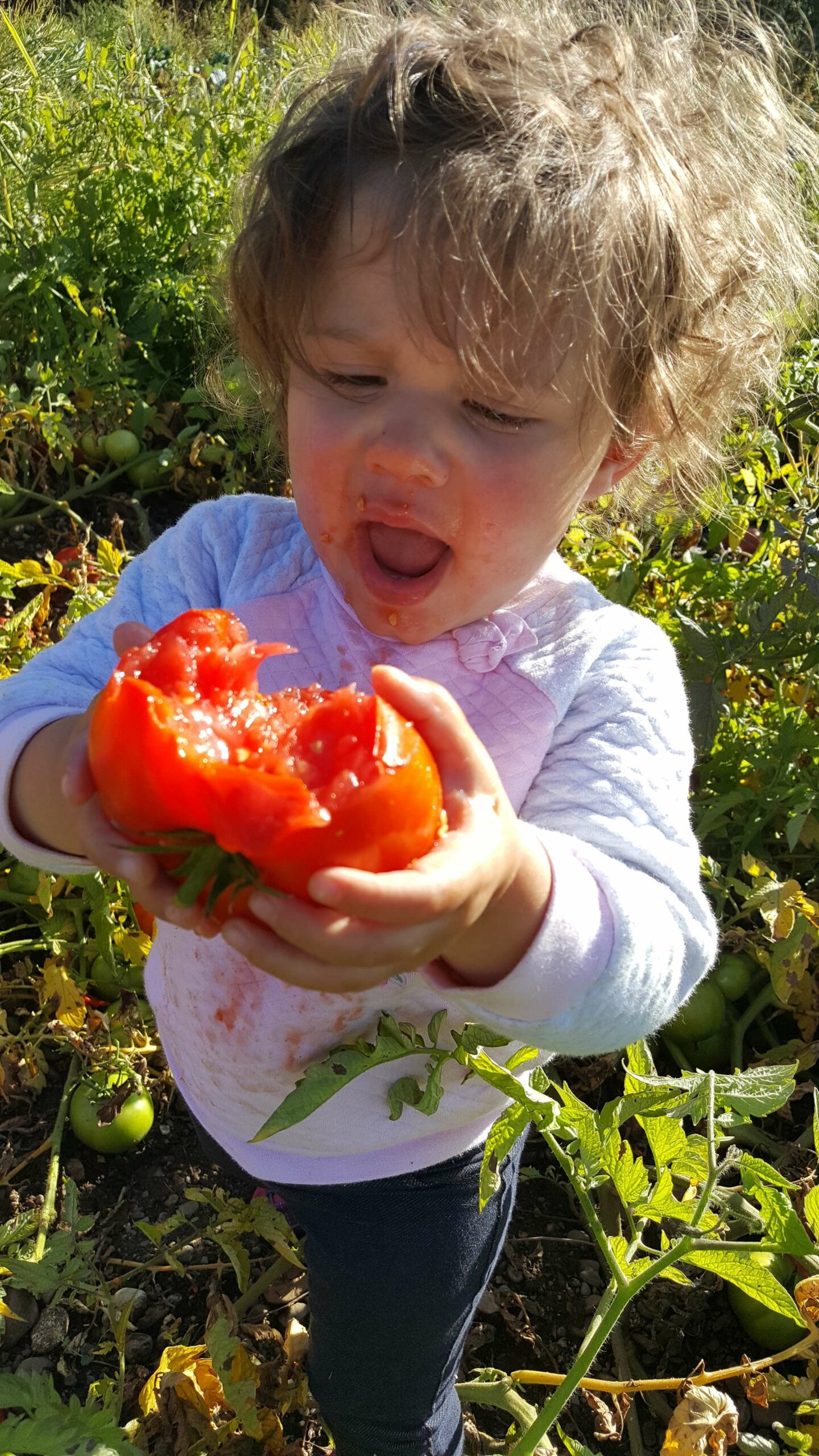
The sensory experience of a fat, juicy tomato!
Our sense of taste is a survival mechanism and helps inform us of what to eat and what not to eat. Interestingly, babies have 2x more taste buds than adults. One reason for this is so babies and children can gather as much information through this sensory system about their world as they can. Essentially, children create a food ‘database’ for sustenance and enjoyment.
Nature offers lots of opportunities for building their ‘database’ of healthy, plant-based food.
Did you ever stick raspberries or olives on each fingertip and then eat them one by one?
Do you remember the excitement of finding a fat, ripe strawberry hidden under a thick layer of leaves?
And, did you know that the more children are involved in the growing of food the more likely they are to eat it? This is great news for parents of picky eaters!!
Put cherry tomatoes or green beans on your picky eater’s dinner plate and you’re likely to get an upturned nose. Strategically locate a cherry tomato plant or climbing beans in their playscape and they may give them a try, because, hey, it’s easier to try something new when you’re having fun than when you’re feeling the pressure of the “no thank you bite”.
Tasting and eating edible plants also improves children’s language and communication skills.
Try this with your kids: You and your kiddo each pick something out of the garden to taste. Take time sensing the flavors. Then, each describe how different things taste.
Encourage them to go beyond basic flavor descriptions, like good, bad, or okay. If it’s sweet, can they describe that sweetness? If it’s sour, how does it make them feel?
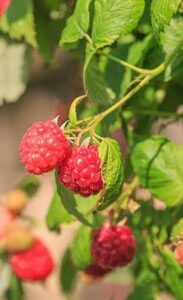
For a dwarf thornless raspberry variety, try Bushel n Berry Raspberry Shortcake.
There are so many ways to include taste experiences in a play and learning space: through edible gardens, potted herbs, or just planting edible plants in the landscape.
What could be more fun than for kids to graze while they play?
How many ways can you bring edible plants into their play space?
Guaranteed, you’ll surprise yourself in how easy it is to create an edible, graze-able playscape.
For kids, it’s so much fun to experiment with this sensory system. Tasting and eating is a symphony of experience, in the blending of flavor, texture, and smell.
What’s more fun for kids than experimenting with their sense of taste?
This is where sensory plants can really shine.
You have your garden staples: the fruits, berries, and veggies plants. Widely available food plants that kids love include strawberries, blueberries, thornless raspberries and blackberries, grapes, figs, apples, apricots, plums, pears, beans, cucumbers, cherry tomatoes, and sugar snap peas.
Some food plants that aren’t mainstream (at least in my northwest climate), and should be given consideration are honeyberry, lingonberry, aronia (hello, superfood!), quince, pawpaw, and jujube, to name a few.
Herbs are multi-sensory plants in that they typically have a strong fragrance to accompany their potent flavor. My favorites for children’s spaces include basil, lemon balm, rosemary, creeping thyme, oregano, chives, mint, and lavender.
Herbs are great in pots and planted out in the landscape. For example, thyme is a creeping plant that can be planted between stepping stones as it can withstand a little foot traffic.
Then, we have plants with edible flowers. Nasturtiums, pansies, calendula, dahlia, peony, roses, lilac, forsythia, apple blossoms, carnations, and hollyhock. And, the list goes on.
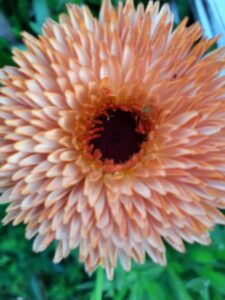
Calendula is a colorful, edible, medicinal flower that’s perfect for children’s areas.
Want to make a salad more appealing and beautiful? Bouge it up with peppery-tasting nasturtium blossoms and mild-flavored rose and calendula petals.
Finally, we have wild edibles! Dandelion, Johnny Jump-Ups, spring violets, clover, lamb’s quarters, wild mustard, chickweed, chicory, amaranth…and I’m just naming plants I’ve found in our own yard!
Foraging wild edible plants is incredibly fun. Quite often we’ll grab a couple bowls and forage greens and edible flowers growing wild on our property. We give it all a good washing, add a little homemade dressing, and…
Voila! YARD SALAD!
Grab a field guide from your local library or install an app on your phone to help you identify wild plants accurately. I’m currently using an app called PlantNet. Foraging for wild plants help kids understand their home landscape and the bounty it offers!
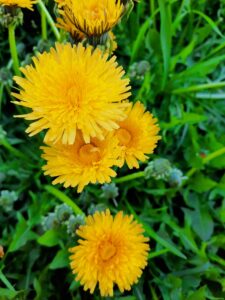
This year we made Dandelion jelly. Incredibly easy, fun, and tasty!
Check out my eBook, Nature Play for the 7 Senses: A Parent’s Guide for Natural PLay & Learning Spaces for ALL Children
There’s a scene from my favorite movie, Amelie, where she’s standing in a quaint little French street in front of a grocer. She pauses beside the produce stand and when no one’s paying any attention, she slowly sinks her hand into a bag of lentils. She closes her eyes as an expression of peace and delight washes over her face. In the midst of the streetscape bustle Amelie experiences calm and a temporary escape through this simple, tactile act.
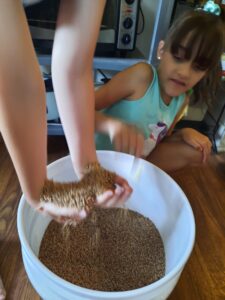
Just like Amelie, my girls are enjoying the feeling and pressure of swirling their hands and arms in a bucket of grain.
As far as the senses go, touch is fundamental to understanding our surroundings and the activities of everyday life. Our largest organ, our skin, is responsible for much of our tactile experiences. Our skin is constantly receiving messages about our environment and communicating those messages to our brain to interpret the experience…and how we need to react to that experience. We’re alerted to danger (when our hand touches a hot stove burner, we quickly pull our hand away!). We feel comfort, calm, and safety (curled on the couch wrapped in a warm, fuzzy blanket…all is well and I can rest).
The greater the variety of tactile experience during childhood, the greater the understanding the child will develop about their environment and more successfully they navigate that environment. Exploring touch is essential for all children, especially those with visual impairments. Whether you have a big yard or a modest apartment balcony, you can easily maximize the tactile quality of your space for your kiddos. How do you do that? Look around you right now. What do you see in various textures? Where and how do you experience warmth, coolness, cold? To add more tactile interest, think temperature and texture. How many ways can kids explore tactile qualities like:
Soft . Fuzzy . Smooth . Hard . Bumpy .
Prickly . Warm . Cool . Cold . Icy .
What else??
If you have kiddos that are hypersensitive or hyposensitive to touch, a space filled with a variety of textures and temperatures will help them explore this sensory system on their own terms and at their own pace which will help bring them self-regulate their nervous system.

Make an easy nature loom out of a garden obelisk, trellis, or fencing.
Give them what they love! Be sure to include lots and lots of the textures they love so their time is as joy-filled as possible. Here are some ideas for adding tactile interest to their play and learning space:
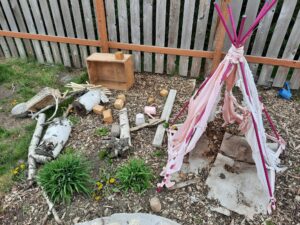
A loose parts play area can look messy at times but that’s ok. The sensory value is off the charts amazing!
Nature is always inviting children to play and connect. Children always want to be hands-on in that experience.
Sensory plants that invite touch are incredible assets in a nature play space. Consider them ambassadors for co-creating children’s nature appreciation and connection.
Through touch, children get to know each plant intimately, and through that process become part of the magic and awe of nature.
Let me say it directly: Children come to know they’re part of nature.
When we slow down and pay attention we really notice the incredible variety of textural interests in the plants and trees around us: the bark, branches, leaves, cones, flowers, seed heads, and pods.
It’s pretty mind boggling.
So, how can you use plants to boost the play and learning value?
Can you use plants to create textural contrast? How about planting purple coneflower next to lamb’s ears? Running your fingers over the spiny seedheads of coneflower are a distinctly different experience than stroking the fleecy, fuzzy leaves of lamb’s ears. There are so many ways to mix-and-match plant textures.
How can tactile plants be used in play activities? Natural loose parts play is a great place to start. I have another post about the play value of loose parts.
Lastly, tactile plants are very effective when planted where children spend lengths of time in an activity, like a sand play area, cozy space, or fairy garden. Plants within arms reach will be reached for, again and again.
Some of my favorite plants for tactile interest include:
Big Ears Lambs Ears, Stachys byzantina ‘Big Ears’, hardiness zones 4-9
This perennial tops my list of tactile favorites! The leaves of lambs ears feels just as soft and fleecy as the name sounds. I much prefer the Big Ears variety (also called Helen von Stein) as it doesn’t spread as enthusiastically as other varieties. This plant is a tagless cotton shirt, if you catch my drift. If you have a kiddo who’s touch averse, this plant offers great potential for exploring that comfort zone.
Approx. 12” tall x 24” wide and spreading
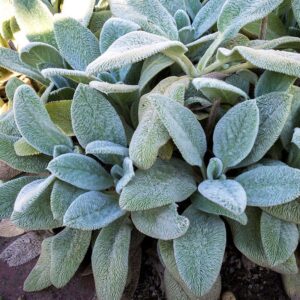
Big Ears Lambs Ears is my all-time fave tactile perennial.
Kim’s Knee High Coneflower, Echinacea purpurea ‘Kim’s Knee High’, hardiness zones 3-8
Coneflowers have a spiny seedhead that it’s really interesting to touch. Don’t prune off the seedheads in the fall. Leave them over the winter for loose parts play and food for birds.
18” tall and wide
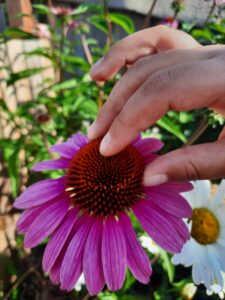
Kim’s Knee High and other coneflower varieties have an interesting seedhead and the pollinators love them!
Woolly Thyme, Thymus pseudolanuginosus, hardiness zones 4-7
Kids can walk barefoot on woolly thyme. As winter makes way to spring, forsythia’s blooms are like radiant sunshine. This early bloomer brings cheer to any early garden. The flowers are also edible and can be used salads or made into jelly, syrup, and tea!
4”-6” tall x 12” wide
Purple Emperor Sedum, Sedum x ‘Purple Emperor’, hardiness zones 3-9
This full sun, drought tolerant perennial is a great tactile plant for its succulent, spongy leaves and its fluffy summertime flower heads. Keep the flower heads on through the winter for four seasons of play value.
12” tall x 18” wide
Little Bunny Dwarf Fountain Grass, Pennisetum alopecuroides ‘Little Bunny’, hardiness zones 4-9
Fountain grass comes in all sizes and Little Bunny is the smallest of them all. This ornamental grass is as cute as its name sounds and makes a special statement in a children’s play spaces with its fine-textured grass blades and super soft seedheads.
12” tall and wide
As always, two friendly reminders: 1) be sure that all plants in the play area are non-toxic, and 2) pesticides, herbicides, and other harmful chemicals should NEVER be used in play areas.
Check out my eBook, Nature Play for the 7 Senses: A Parent’s Guide for Natural PLay & Learning Spaces for ALL Children
